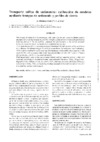Identificador persistente para citar o vincular este elemento:
https://accedacris.ulpgc.es/jspui/handle/10553/76572
| Campo DC | Valor | idioma |
|---|---|---|
| dc.contributor.author | Alcántara-Carrió, J. | en_US |
| dc.contributor.author | Alonso, I. | en_US |
| dc.date.accessioned | 2020-12-11T15:42:46Z | - |
| dc.date.available | 2020-12-11T15:42:46Z | - |
| dc.date.issued | 2000 | en_US |
| dc.identifier.issn | 1576-5172 | en_US |
| dc.identifier.uri | https://accedacris.ulpgc.es/handle/10553/76572 | - |
| dc.description.abstract | The lsthmus of Jandfa (5 of Fuerteventura), with more than 54 km21 presents different aeolian deposits such as dunes, sandsheets, and serir. Actual/y, a great amount of sediments are blowing from the lsthmus to the lee beaches. Therefore, the quantificatíon of the aeolían sediment transport is basic far Lhe characterisation of its sedimentarv dynamic. To calibrate the models it is necessary to apply some empírica! methods such as the use of sand traps. Between the different designs of sand traps we are chosen the Leatherman one (Leatherman, 1978), slightly modified to avoid scouring. Simultaneously wind profiles were measurec! at the same loca/ion with an anemorneter lower (cup anemometers at 0.23, 0.5, 1 and 4 m height) during one day, with 5 minutes sampling period. Field experiments were carried out at seven stations and two seasonal periods (winter and summer), and final/y, six lheoretical mode/s were calibrated: Kawamura (7 951 ), Zingg (1 952), Bagnold (1 956), Wil/iams (1 964), /-/su (1 973, 1977), and Lettau & Lettau (7 978) (see references in Sherman & Hotta, 7 990). In conclusion, the Bagnold mode/ is the most accurate one in arder to predict the aeolian sand transport. | en_US |
| dc.language | spa | en_US |
| dc.relation | 1/94 (Consejería de Educación y Cultura, Gobierno de Canarias) | en_US |
| dc.relation.ispartof | Geotemas (Madrid) | en_US |
| dc.source | Geotemas [ISSN 1576-5172]. v. 1 (2), p. 29-33 | en_US |
| dc.subject | 250618 Sedimentología | en_US |
| dc.subject.other | Aeolian sand transport | en_US |
| dc.subject.other | Sand traps | en_US |
| dc.subject.other | Wind profi!es | en_US |
| dc.subject.other | Ca!ibration | en_US |
| dc.subject.other | Canary lslands | en_US |
| dc.title | Transporte eólico de sedimetos: calibración de modelos mediante trampas de sedimento y perfiles de viento | en_US |
| dc.type | info:eu-repo/semantics/conferenceObject | en_US |
| dc.type | conferenceObject | en_US |
| dc.relation.conference | V Congreso Geológico de España | en_US |
| dc.description.lastpage | 33 | en_US |
| dc.description.firstpage | 29 | en_US |
| dc.relation.volume | 1 | en_US |
| dc.investigacion | Ciencias | en_US |
| dc.type2 | Actas de congresos | en_US |
| dc.description.numberofpages | 5 | en_US |
| dc.identifier.ulpgc | Sí | en_US |
| dc.contributor.buulpgc | BU-BAS | en_US |
| item.fulltext | Con texto completo | - |
| item.grantfulltext | open | - |
| crisitem.author.dept | GIR IOCAG: Geología Aplicada y Regional | - |
| crisitem.author.dept | IU de Oceanografía y Cambio Global | - |
| crisitem.author.orcid | 0000-0002-9663-0773 | - |
| crisitem.author.parentorg | IU de Oceanografía y Cambio Global | - |
| crisitem.author.fullName | Alonso Bilbao,Ignacio | - |
| Colección: | Actas de congresos | |
Visitas
72
actualizado el 10-ene-2026
Descargas
102
actualizado el 10-ene-2026
Google ScholarTM
Verifica
Comparte
Exporta metadatos
Los elementos en ULPGC accedaCRIS están protegidos por derechos de autor con todos los derechos reservados, a menos que se indique lo contrario.
